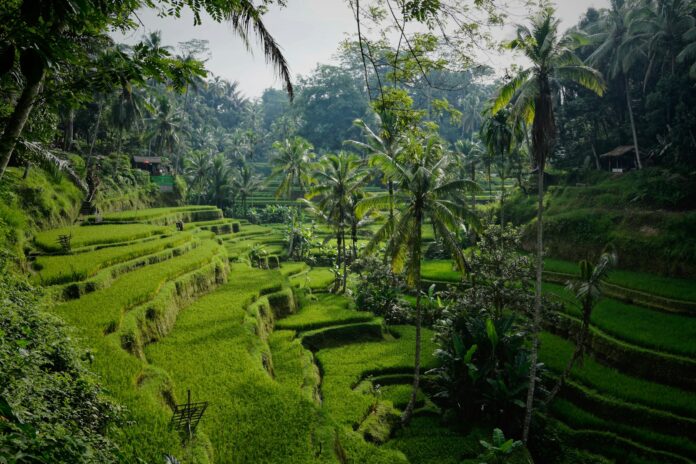Introduction to the Tanah Lot and North Bali Tour
Bali, a jewel of Indonesia, is famed for its lush landscapes, ancient temples, and vibrant culture. Among the many destinations that captivate travelers, Tanah Lot and North Bali stand out for their breathtaking scenery and deep cultural roots. This guide takes you on a journey through some of Bali’s most iconic sites: the stunning sea temple of Tanah Lot, the serene Jatiluwih Rice Terraces, the scenic Gitgit Waterfall, and the historical town of Singaraja. Each location offers a unique glimpse into Bali’s rich history and natural beauty.
Tanah Lot: The Iconic Sea Temple
History and Significance of Tanah Lot
Tanah Lot, perched on a rocky outcrop amidst the crashing waves of the Indian Ocean, is one of Bali’s most revered sea temples. This iconic site is dedicated to Dewa Baruna, the sea god, and has been a place of worship for Balinese Hindus for centuries. The name “Tanah Lot” translates to “Land in the Sea,” perfectly describing the temple’s unique location.
According to legend, Tanah Lot was established in the 16th century by Dang Hyang Nirartha, a priest who traveled along the south coast of Bali. Impressed by the natural beauty of the area, he decided to build a temple on the rock to honor the sea god. Today, Tanah Lot is not only a spiritual hub but also one of Bali’s most photographed landmarks, drawing visitors from around the world.
What to Expect During Your Visit
Visitors to Tanah Lot can expect a truly magical experience, especially during the early morning or late afternoon when the light creates dramatic silhouettes against the temple. The temple is only accessible at low tide, and the sight of the waves crashing against the rocks adds to its mystical allure. During high tide, the temple appears to float on the water, making for a stunning visual.
As you approach the temple, you’ll walk through a lively market filled with vendors selling souvenirs, traditional crafts, and local snacks. The temple grounds offer several vantage points where you can take in the panoramic views of the coastline. Don’t miss the chance to receive a blessing from the priests at the freshwater spring, which is believed to have holy water.
Sunset at Tanah Lot
One of the most popular times to visit Tanah Lot is during sunset when the temple is bathed in a golden glow. The sunset view from Tanah Lot is considered one of the best in Bali, with the temple silhouetted against the colorful sky. It’s a perfect way to end your day and capture the beauty of Bali’s natural and spiritual landscapes.
Booking Your Visit
To experience Tanah Lot without the hassle of navigating on your own, consider booking a guided tour through Viator. These tours often include transportation, entrance fees, and a knowledgeable guide who can provide insights into the history and significance of the temple. Many tours also include visits to other attractions in North Bali, making it a convenient way to explore the region.
Jatiluwih Rice Terraces: A UNESCO World Heritage Site
The Beauty of Jatiluwih Rice Terraces
The Jatiluwih Rice Terraces, located in the heart of Bali’s Tabanan Regency, are a testament to the island’s agricultural heritage. These stunning terraces are part of Bali’s Subak system, an ancient irrigation method that has been recognized as a UNESCO World Heritage Site. The terraces stretch across 600 hectares of lush green hills, offering a breathtaking view of Bali’s rural landscape.
The word “Jatiluwih” translates to “truly marvelous,” and it’s easy to see why. The terraces are meticulously maintained by local farmers, who continue to practice traditional farming methods passed down through generations. The result is a landscape that is not only beautiful but also a living example of sustainable agriculture.
Exploring the Rice Terraces
A visit to the Jatiluwih Rice Terraces offers a chance to experience the tranquility of Bali’s countryside. The terraces are best explored on foot, with several walking paths that allow you to immerse yourself in the natural beauty of the area. As you wander through the terraces, you’ll pass by traditional Balinese farmhouses, watch farmers tending to their crops, and enjoy the peaceful ambiance of the surrounding nature.
The Jatiluwih Rice Terraces are also a great place to learn about Bali’s Subak system. This communal irrigation method is based on the Hindu philosophy of Tri Hita Karana, which emphasizes harmony between humans, nature, and the gods. The Subak system not only provides water to the rice fields but also fosters a sense of community among the farmers.
Best Time to Visit
The best time to visit the Jatiluwih Rice Terraces is during the rice growing season, which typically falls between March and September. During this time, the terraces are a vibrant green, and you can see the rice plants in various stages of growth. The terraces are also particularly beautiful during the early morning or late afternoon when the light creates a soft, golden glow over the landscape.
Booking Your Visit
To fully appreciate the beauty and significance of the Jatiluwih Rice Terraces, consider booking a guided tour through Viator. Many tours include a visit to the rice terraces as part of a broader itinerary that explores North Bali’s natural and cultural attractions. A knowledgeable guide can provide valuable insights into the history and importance of the terraces, making your visit even more enriching.
Gitgit Waterfall: Nature’s Symphony
The Allure of Gitgit Waterfall
Gitgit Waterfall, located in the northern part of Bali, is one of the island’s most impressive natural attractions. Surrounded by lush tropical forests, the waterfall cascades down a rocky cliff into a serene pool below. The sound of the rushing water, combined with the cool mist that rises from the falls, creates a refreshing and rejuvenating atmosphere.
The waterfall is easily accessible from the main road, with a short walk through the forest leading to the viewing area. Along the way, you’ll pass by small shops selling local handicrafts and snacks, as well as several smaller waterfalls that add to the charm of the area. The trail is well-maintained, making it suitable for visitors of all ages.
Exploring the Surroundings
While Gitgit Waterfall is the main attraction, the surrounding area offers plenty of opportunities for exploration. The lush forest is home to a variety of flora and fauna, and you may spot monkeys, birds, and butterflies as you make your way to the waterfall. The area is also known for its rich coffee plantations, and you can visit a nearby coffee shop to sample some of Bali’s famous coffee.
The pool at the base of the waterfall is a popular spot for swimming, and the cool water provides a refreshing break from the tropical heat. However, be sure to take care when swimming, as the rocks can be slippery, and the current can be strong after heavy rains.
Photography Tips
Gitgit Waterfall is a photographer’s dream, with its dramatic setting and natural beauty. To capture the best photos, visit the waterfall during the early morning or late afternoon when the light is soft and diffused. A wide-angle lens is ideal for capturing the full height of the waterfall, while a slower shutter speed can create a silky effect in the flowing water.
Booking Your Visit
For a hassle-free experience, consider booking a guided tour to Gitgit Waterfall through Viator. Many tours include transportation, entrance fees, and a guide who can provide insights into the natural and cultural significance of the area. A visit to Gitgit Waterfall can also be combined with other attractions in North Bali, such as the Jatiluwih Rice Terraces and the town of Singaraja.
Singaraja: The Historical Capital of North Bali
A Glimpse into Bali’s Colonial Past
Singaraja, located on the northern coast of Bali, is a town steeped in history and culture. Once the capital of Bali during the Dutch colonial period, Singaraja retains much of its colonial charm, with its wide streets, old buildings, and historic landmarks. The town’s name, which means “Lion King,” reflects its importance as a center of power and influence in Bali’s history.
Singaraja was a major trading port during the colonial era, and its diverse population includes Balinese, Javanese, Chinese, and Arab communities. This cultural diversity is reflected in the town’s architecture, cuisine, and traditions, making it a fascinating place to explore.
Exploring Singaraja’s Landmarks
One of the best ways to explore Singaraja is on foot, as the town is compact and easy to navigate. Start your visit at the Puri Agung Buleleng, the former royal palace, which offers a glimpse into the life of Bali’s royal family. The palace is now a museum, showcasing a collection of artifacts, traditional costumes, and historical photographs.
Next, visit the Gedong Kirtya Library, which houses a unique collection of lontar manuscripts, ancient texts written on palm leaves. These manuscripts contain a wealth of knowledge on Balinese culture, religion, and history, and the library is one of the few places where you can see them up close.
Singaraja is also home to several important temples, including the Pura Dalem Jagaraga, known for its intricate carvings and historical significance. The temple is dedicated to the spirits of the dead and is a place of worship for the local community.
Shopping and Dining in Singaraja
Singaraja’s markets are a great place to experience the local culture and pick up some souvenirs. The Pasar Anyar Market is a bustling place where you can find fresh produce, traditional snacks, and handmade crafts. Be sure to try some of the local specialties, such as Sate Lilit (minced fish satay) and Lawar (a spicy Balinese salad).
For dining, Singaraja offers a mix of traditional Balinese warungs and more modern restaurants. The town’s diverse population is reflected in its cuisine, with influences from Javanese, Chinese, and Arab cooking. Many of the restaurants are located along the waterfront, offering stunning views of the ocean.
Booking Your Visit
To make the most of your visit to Singaraja, consider booking a guided tour through Viator. A knowledgeable guide can provide insights into the town’s history and culture, making your visit even more enriching. Many tours also include visits to other attractions in North Bali, such as the Gitgit Waterfall and the Jatiluwih Rice Terraces, providing a comprehensive experience of the region.
Conclusion
A tour of Tanah Lot and North Bali offers a unique blend of natural beauty, cultural heritage, and historical significance. From the iconic sea temple of Tanah Lot to the serene Jatiluwih Rice Terraces, the refreshing Gitgit Waterfall, and the historic town of Singaraja, each destination provides a distinct perspective on Bali’s rich and diverse landscape.
For a seamless and enriching experience, we recommend booking a guided tour through Viator. This allows you to fully immerse yourself in the sights and sounds of North Bali without the stress of planning and navigating on your own.
For more travel inspiration and tips, visit Izase, your trusted source for lifestyle and travel content. Please note that while we strive to provide accurate information, there may be modifications or changes to the details provided, so it’s always best to check the booking page on Viator for the most up-to-date information.
MORE FROM IZASE


